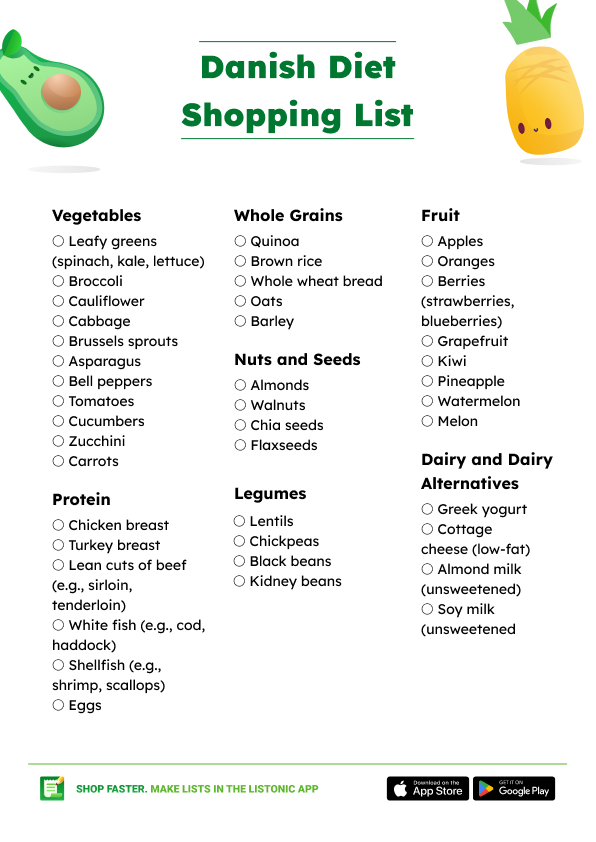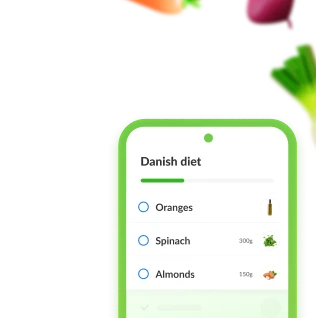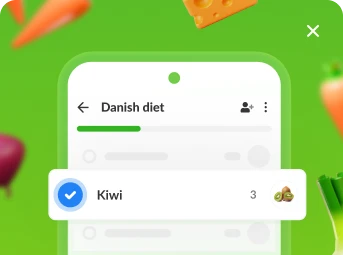Privacy Policy | Terms of services | Cookies Policy | © 2006-2024 Listonic. All rights reserved. Listonic Dev, and Listonic Ads are part of Listonic.
Danish Diet Shopping List (+ PDF)
July 28, 2023
Considering going on the Danish diet? Due to its low calorie intake and short duration, it can be a great way to kickstart your weight loss journey. In this article, we will explore the principles of the Danish diet and provide you with a handy shopping list to help you get started.
Table of contents
The Danish Diet Shopping List
Danish Diet Guidelines
Danish Diet Shopping List Breakdown
What Else to Keep in Mind?
Conclusions
The Danish Diet Shopping List
Danish Diet Guidelines
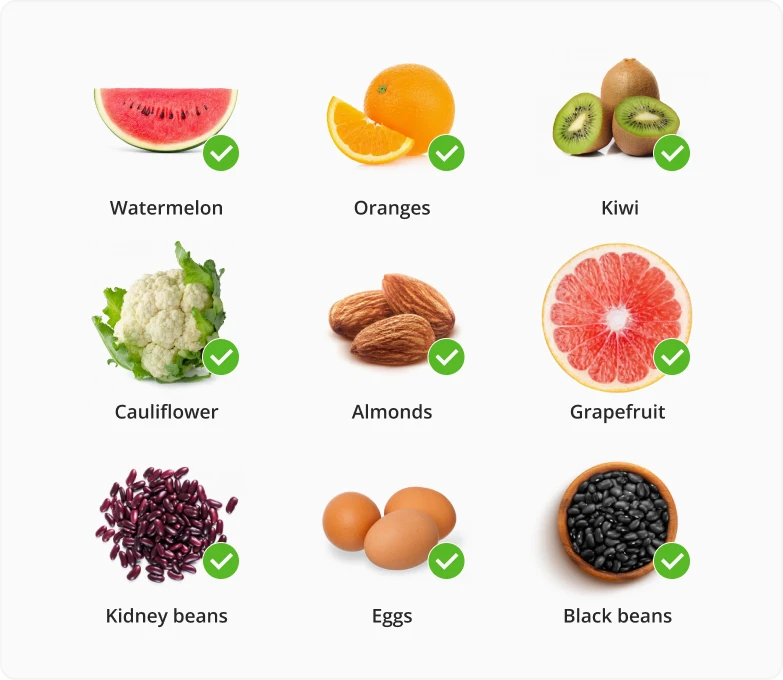
The Danish diet, known also as the Copenhagen diet or Denmark Diet, is a popular weight loss program that focuses on a low-calorie and high-protein approach to help you shed pounds. During the 13-day cycle, the calorie intake is relatively low, ranging from 600 to 1000 calories per day, depending on your specific goals.
When composing your meals, ensure that each meal consists of lean proteins, vegetables, and healthy fats. This combination will provide your body with essential nutrients while keeping the calorie intake in check.
Portion control is essential. Pay close attention to serving sizes and calorie values. Additionally, listen to your body’s hunger and fullness cues to avoid overeating.
Also, establish a regular meal schedule with three balanced meals a day and void snacking between meals, as it can add excessive calories.
You should also drink plenty of water throughout the day to stay hydrated and curb your cravings. Opt for water, herbal tea, or unsweetened coffee instead of sugary beverages.
Danish Diet Shopping List Breakdown
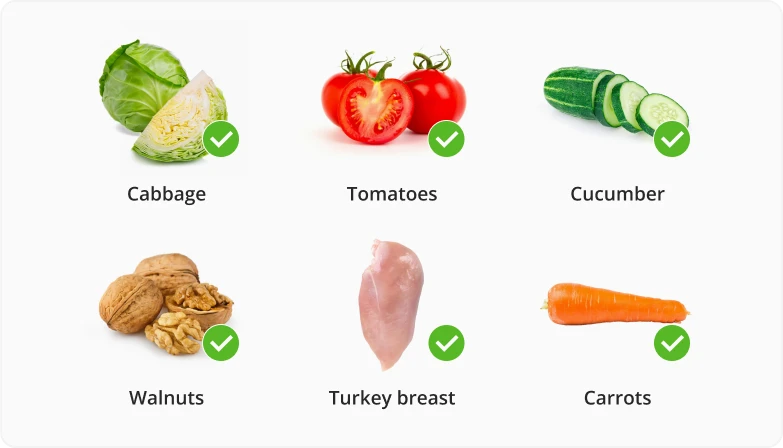
Lean Protein
Lean protein sources like chicken breast, turkey breast, and white fish are low in fat and provide essential nutrients while supporting muscle maintenance. They are satiating and help you to keep the calories in check.
Vegetables
Vegetables are a key part of the Danish diet, as they are low in calories and high in fiber, vitamins, and minerals. They provide important nutrients and also boost the volume of your meals without a significant increase in calories. They promote weight management and gut health.

Fruits
Fruits offer natural sweetness, fiber, and many vitamins and minerals. They can be enjoyed as a healthy snack or a refreshing addition to your meals, making the diet more enjoyable and varied.
Whole Grains
Whole grains like quinoa, brown rice, and whole wheat bread are a source of complex carbohydrates, fiber, and other micronutrients. They stabilise your energy levels and keep you full for longer after a meal.
Legumes
Legumes such as lentils, chickpeas, and black beans are rich in plant-based protein and fiber. These nourishing ingredients can serve as satisfying alternatives to meat and add variety to your daily meals.
Dairy and Dairy Alternatives
You can eat moderate amounts of dairy products like Greek yogurt and cottage cheese or their plant-based alternatives (such as almond milk or soy milk). These flavourful options can add calcium and protein to your diet, but remember to control the portion sizes.
Nuts and Seeds
They contain healthy fats, protein, and additional nutrients, so you are encouraged to eat them in moderation. They can add crunch and flavor to your meals or serve as a satisfying snack.
Get a Danish Diet Grocery List on Your Phone!
Add & remove items
Sort items by store aisles
Share the list with your partner

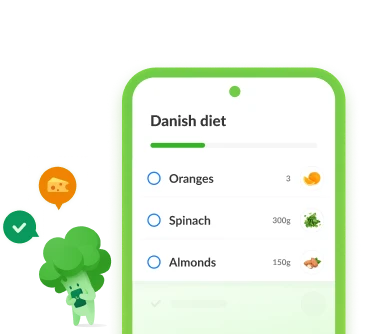
What Else to Keep in Mind?
What Foods to Avoid?
When on the Danish diet, you should cut down on:
Sugar and sugary foods: This includes sweets, candies, desserts, and sugary beverages. They are typically high in calories and provide little nutritional value.
Processed and packaged products: Foods like chips, crackers, fast food, and frozen meals often contain unhealthy fats, excessive sodium, and added sugars.
High-fat dairy products: Full-fat dairy products, such as full-fat milk, cream and high-fat cheeses, are calorie-dense and high in saturated fat. Choose low-fat or fat-free alternatives.
White flour and refined grains: Foods made with white flour, such as white bread, pasta, and pastries, tend to be low in fiber and nutrients.
Fried and fatty foods: Deep-fried foods, greasy snacks, and fatty cuts of meat should be limited. They are high in unhealthy fats and calories, which can hinder your weight loss progress.
Alcohol: Alcoholic beverages are high in calories and detrimental for your overall health. You should avoid them or limit their consumption to a minimum.
What Are The Cons of the Danish Diet?
Here are a few points to keep in mind when going on the Danish Diet:
Restrictive nature: The Danish diet is very restrictive, with low calorie intake and limited food choices. For this reason, this diet can be challenging to follow in the long run.
Nutrient deficiencies: It can be challenging to meet the recommended daily intake of essential nutrients such as vitamins, minerals, and fiber. Nutrient deficiencies can have negative effects on overall health and well-being.
Potential muscle loss: The low-calorie and protein-restrictive approach may lead to muscle loss along with fat loss. This can have a negative impact on your metabolism.
Conclusions
If you are interested in trying the 13 day Danish diet and shedding a few pounds, keep our guide at hand. You can download the shopping list in a PDF version or open it in the mobile Listonic app to customize the list easily. However, you should remember that the Danish diet is an intense and restrictive program. After completing it, you should transition to a more balanced and varied diet with a higher calorie intake.
